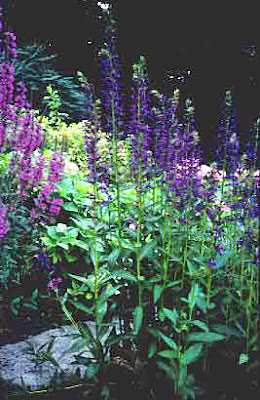Perennials to add
 Since we finally had some rain and it's cooled down, I'm feeling hopeful that fall really is a good time for planting. A quick run up to two local nurseries (actual nurseries, not just the garden centers at the big box stores) found me nabbing some good additions for my fall garden. A lobelia, set aside for a butterfly-gardening client who never showed up, caught my eye. These plants had beautiful large blue spikes, were being visited by carpenter bees and butterflies, were flowering in small pots and were labeled Lobelia x speciosa 'Fan Blue.' In spite of not really having appropriately moist soil anywhere, I thought I'd try them. They were half-price, anyway. I also picked up some selections of one of our native asters, Aster novae-belgiae (New York Aster), a pot of society garlic (Tulbaghia violacea), some Viola, and a couple of pots of Spanish lavender, which flowered profusely in one of my containers this summer, and was heavily visited by bees.
Since we finally had some rain and it's cooled down, I'm feeling hopeful that fall really is a good time for planting. A quick run up to two local nurseries (actual nurseries, not just the garden centers at the big box stores) found me nabbing some good additions for my fall garden. A lobelia, set aside for a butterfly-gardening client who never showed up, caught my eye. These plants had beautiful large blue spikes, were being visited by carpenter bees and butterflies, were flowering in small pots and were labeled Lobelia x speciosa 'Fan Blue.' In spite of not really having appropriately moist soil anywhere, I thought I'd try them. They were half-price, anyway. I also picked up some selections of one of our native asters, Aster novae-belgiae (New York Aster), a pot of society garlic (Tulbaghia violacea), some Viola, and a couple of pots of Spanish lavender, which flowered profusely in one of my containers this summer, and was heavily visited by bees.A web search revealed that Lobelia x speciosa is a hybrid of two of our North American natives, L. cardinalis (Cardinal flower) and L. siphilitica (Great Blue Lobelia), which results in a range of flower colors that have subsequently been named as cultivars. Wray Bowden, a Canadian horticulturist, apparently did the original crosses, although the hybrid is also credited as being of German origin, and one of his early successes ('Queen Victoria') was a Royal Horticultural Society Award winner in 1993. Since the hybrids proved to be great in gardens, they're now being grown in temperate climates around the world. I found references in New Zealand, Australia, and Europe. The nice picture is one taken by a Swedish botanist, foto: Hans-Otto Tengrud, from his website: http://www.arborea.se. Unfortunately, I couldn't make out the Swedish (just enough to identify the country, I think), but he seemed to be a photographer who took pictures of plants.
 The garden centers, to be sure, had some interesting selections, too, thanks to the tendency of the wholesale nursery businesses to keep providing 'something new' even if they're not really new, but just a new form or an old favorite rediscovered. A perennial I picked up at one of the garden centers, not in flower, so easy to overlook, was a robust quart size pot of Raspberry Wine Bee Balm. It had beautiful foliage and looked very healthy, and even though, again, I really don't have a moist soil site, I succumbed.
The garden centers, to be sure, had some interesting selections, too, thanks to the tendency of the wholesale nursery businesses to keep providing 'something new' even if they're not really new, but just a new form or an old favorite rediscovered. A perennial I picked up at one of the garden centers, not in flower, so easy to overlook, was a robust quart size pot of Raspberry Wine Bee Balm. It had beautiful foliage and looked very healthy, and even though, again, I really don't have a moist soil site, I succumbed.This turns out to be a White Flower Farm introduction, the source of this photo. It sounds like a great selection, mildew-resistant and long-flowering. and attractive to hummingbirds (which is why I bought it in the first place). Monarda didyma is a great Eastern U.S. native, and its selections certainly are worth trying. Our Monarda 'Jakob Kline' in the pollinator border outside the Nature Center at work attracted lots of hummingbirds, although it suffered in the dry summer this year.
Comments
Post a Comment
I enjoy hearing from fellow nature lovers and gardeners. Let me know your thoughts.